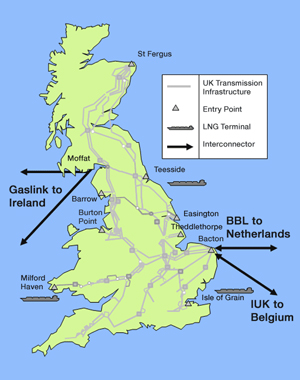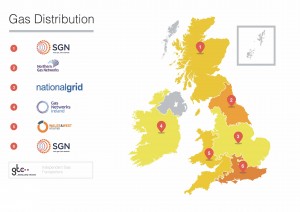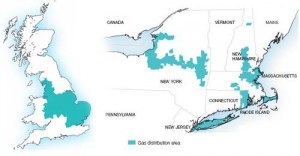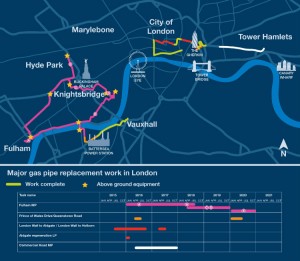January 2016, Vol. 243, No. 1
Features
National Grid at Home and Abroad

National Grid is a British-based multinational pipeline and power networks company with operations in the United Kingdom and northeastern United States. It is one of the largest investor-owned energy companies in the world and is listed on both the New York and London Stock Exchanges.
According to National Grid’s most recent report and accounts, it made profits of £3,780 million and employed 24,274 people in 2014-15. This article looks at some of its United Kingdom and U.S. gas operations.
UK National Grid
National Grid is the sole owner and operator of the national gas transmission system (NTS) built after the onset of North Sea Gas supplies in 1967. The gas transmission system is comprised of 7,600 km of high-pressure pipe and 26 compressor stations, connecting to eight regional distribution networks and to third-party independent systems for onward transportation of gas to end-consumers.
In essence, NTS distributes all gas arriving in the U.K. by pipeline from offshore North Sea gas fields, gas imported or exported through interconnectors with Belgium, Holland, Norway and Ireland, and gas shipped to U.K. regasification import terminals from countries, including Qatar, Angola and Nigeria. Starting this year, the list will include the United States.
National Grid also owns four of the country’s eight regional distribution networks (Figure 1). Of the five regasification terminals in the U.K., the company owns and operates the Isle of Grain LNG importation terminal near London. Its LNG terminal is the largest in Europe with yearly capacity of 15 million tons, sufficient to meet 20% of the UK forecast demand.
According to a National Grid spokesman, “Grain is a world-class facility that receives cargoes from all across the globe. We have the facilities in place to accept LNG from the U.S.”
Gas Transmission
Figure 1 shows the main entry and exit points for gas. Bacton in East Anglia, which has a throughput of 13.5 MMcm/d, is the main entry point for pipeline imports from the southern North Sea gas fields and from the European mainland.
Gas from either Belgium or Holland can come from gas fields in Europe or as far away as Siberia and the Caspian Sea. St. Fergus, in North East Scotland, is the main entry point for gas from British and Norwegian gas fields in the northern part of the North Sea, while Moffat on the west coast is the main export point for pipeline gas deliveries to neighboring Ireland.
Gas leaves the transmission system and enters the distribution network at high pressure. It is then transported through a number of reducing pressure tiers until it final delivery to consumers.
Distribution Networks

Gas leaves National Grid’s transmission network at 49 points for distribution by eight regional networks to customers, including 40 gas power stations, industrial users and households. Gas producers and importers sell gas to licensed shippers who pay for its transmission and distribution. National Grid’s four regional distribution networks provide access to about 10.8 million consumers (Figure 2).
Gas Market
National Grid UK faces declining demand for gas owing to the growth in renewable energy, increased energy efficiency and competition from coal, which has resulted in mothballing of some gas-fueled generation plants in Britain.
The company is also fending off “huge amounts” of cybersecurity threats, some from the Middle East and “a lot from China,” though only a handful have penetrated the company’s computer systems, CEO Steve Holliday told Bloomberg recently.
US National Grid
Founded in 2001, National Grid North America Inc. operates as an electricity and gas company in the U.S. Northeast. Significantly, U.S. gas demand has been rising. Because of the onset of increasing flows of Marcellus shale gas and low wholesale gas prices, more households and industry in the Northeast are switching to gas.

In response, the company is investing in the capacity of its regional gas pipelines and upgrading its LNG importation terminal in Rhode Island. Currently, National Grid North America delivers gas to about 3.5 million customers through its gas transmission infrastructure in upstate New York, New Hampshire, Massachusetts, Rhode Island and New Jersey (Figure 3).
In coming years, interstate gas pipeline capacity on the Millennium Pipeline and Iroquois Gas Transmission system, which is partly owned by National Grid, will be needed to accommodate the increase in shale gas flowing toward the Northeast.
Ongoing UK Projects
A snapshot of National Grid’s ongoing projects illustrates the breadth of its activities. In London, National Grid is investing nearly £1 billion to replace and upgrade more than 1,800 miles of old metal gas mains with safer and more durable pipe.

For the most part, the company is inserting new pipe into the old to reduce digging and noise disruption to residents, businesses and road users. Due for completion in 2021, this investment should reduce the need for unplanned work on the capital city’s network (Figure 4).
Further north, National Grid is about to build a replacement 5-km natural gas pipeline across the River Humber estuary to link gas imports at Easington, on the East Yorkshire coast, to the national transmission network.
To protect the pipeline from erosion, it will be buried in a trench on the river bed, covered with gravel-filled bags topped by concrete plastic frond mattresses to mimic seaweed and encourage the settlement of sand and silt.
National Grid is studying ways of capturing up to 90% of the CO2 produced by power stations and heavy industry. Its Carbon Capture and Storage (CCS) project requires construction of a cross-country pipeline and a subsea pipeline to transport captured carbon dioxide in the Yorkshire and Humberside region to a permanent geological storage site beneath the North Sea.
This project could capture up to 2 million tons of carbon dioxide a year. If proved commercially viable, “this could be at the heart of the development of a £10 billion-plus industry in the U.K. by 2030, enabling Britain to meet climate-change goals,” said National Grid Storage Development Manager Richard Holdgate.
On the other side of the Atlantic, in October, National Grid announced plans to spend $100 million to expand its LNG gasification facilities in Rhode Island. The new facility will siphon gas from an adjacent pipe, use nitrogen to cool it down from about 60 degrees to minus 260 degrees and turn it into a liquid, and then store it in the existing tank farm.
“The proposal is necessary to maintain a diversity of fuel sources in the region as more people use natural gas for heating,” said David Graves, a spokesman for National Grid.
Designed to provide gas for peaking power plants in the region, construction is scheduled to begin in 2016 and be online for the winter of 2018.
On both sides of the Atlantic, National Grid will gain from rising renewable energy inputs, which will require more investment in transmission networks to connect new sources and reinforce the network.
By Nicholas Newman, Contributing Editor





Comments